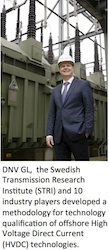DNV GL, together with the Swedish Transmission Research Institute (STRI) and 10 wind industry companies have developed a methodology for technology qualification of offshore High Voltage Direct Current (HVDC) technologies through a joint industry project.
With the development of wind farms further offshore there is an increasing need for long-distance underwater power transmission. The use of HDVC transmission allows power transmission through cables over longer  distances and higher capacities compared to what is feasible when using AC transmission. To date, though, companies have little experience using HVDC transmission technologies and as such, there are no relevant standard, guidelines or recommendations for its successful use.
distances and higher capacities compared to what is feasible when using AC transmission. To date, though, companies have little experience using HVDC transmission technologies and as such, there are no relevant standard, guidelines or recommendations for its successful use.
Peter Vaessen, segment director future transmission grids at DNV GL said of the new guidelines, “Implementation of new technology always introduces uncertainties that imply risk for its developers, manufacturers and end-users. With this technology qualification, we enable our customers to provide the evidence that the technology used will function within the specified limits with an acceptable level of confidence. Customers can ensure that each step is agreed in advance with the technology provider and the buyer, whilst delivering projects on time.”
As a means to manage the technology risks associated with offshore HVDC transmission projects, the new recommended practice is based on DNV GL’s methodology for technology qualification, which has been used extensively for managing technology risks in the oil and gas industry for more than a decade. Technology qualification is a method for providing evidence that technical equipment will function within specified operational limits with an acceptable level of confidence, both for suppliers and buyers of the relevant equipment.
Companies that participated during the testing process included: ABB, Alstom Grid, DONG Energy, Elia, Europacable, Scottish Power, Statkraft, Statnett, Statoil, Svenska Kraftnät and Vattenfall.

